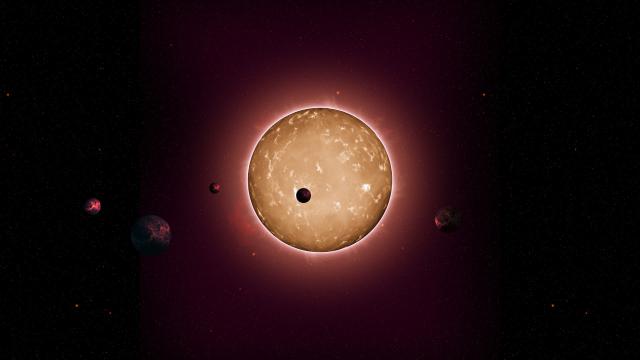Red dwarfs are the most common type of star in the galaxy. But new research suggests that life within these systems may be limited, due to the stiflingly hot atmospheres on Earth-sized planets that orbit the red dwarfs.
An artist’s impression of the red dwarf planetary system Kepler-444. (Image: Tiago Campante/Peter Devine)
When we look up into the sky at night, we only see a small portion of what’s actually out there. Even though red dwarfs comprise over three-quarters of all stars in the Milky Way, not a single one of them is visible to the naked eye. These stars may be small and dim, but they still feature planets, including many that are Earth-like in terms of size and composition. Given their ubiquity, astrobiologists have speculated that a hefty portion of alien life, should it exist, may reside in red dwarf systems.
Unfortunately for alien-hunting hopefuls, new research published in the Monthly Notices of the Royal Astronomical Society suggests otherwise. Despite the fact that red dwarfs are tiny and dim, many of their planets may still be too hot to be habitable — even those situated within a star system’s habitable zone, that is, the zone in which rocky planets can sustain liquid water at the surface.
“It was previously assumed that planets with masses similar to Earth would be habitable simply because they were in the ‘habitable zone’,” said Princeton astronomer and study lead author James Owen in a statement. “However, when you consider how these planets evolve over billions of years, this assumption turns out not to be true.”
Here’s the problem: Many of these planets begin with super-thick atmospheres comprised of noxious hydrogen and helium, comprising around one per cent of the total planetary mass. That’s a hideously huge amount. By comparison, the Earth’s atmosphere accounts for just a millionth of its mass. Thick atmospheres produce greenhouse gas effects that render the surface far too hot for liquid water, so these planets are not considered habitable — at least not at this early stage in their life cycle.
Prior to this study, scientists had figured that, over time, these thick atmospheres evaporate away owing to the steady bombardment of strong X-ray and ultraviolet radiation from the parent dwarf. But this doesn’t appear to be the case. Computer models show that these thick hydrogen and helium envelopes cannot escape the gravity of planets that are similar in size or larger than Earth. This likely means that Earth-sized planets within red dwarf systems are permanently sterile.
There is some good news, however. Smaller planets, like those the size of Mars and Mercury, lose their oppressive atmospheres over time.
“There are hints from recent exoplanet discoveries that relatively puny planets may be even more common around red dwarfs than Earth mass or larger ones, in which case there may indeed be a bonanza of potentially habitable planets whirling around these cool red stars,” said Imperial college of London and study co-author Subhanjoy Mohanty.
So while discouraging, this finding doesn’t mean we should stop looking for signs of life in red dwarf systems. Given the sheer number of these things, it would be a mistake to do otherwise.
